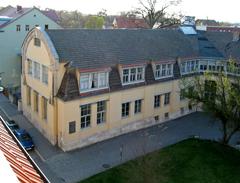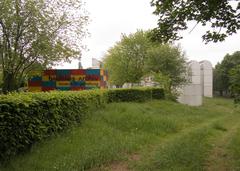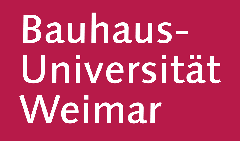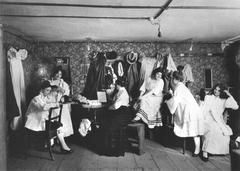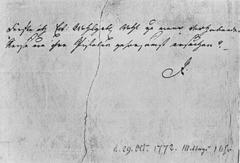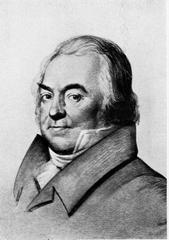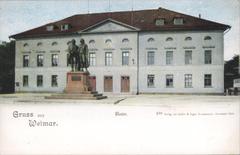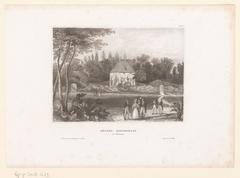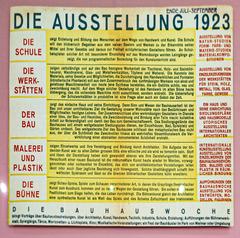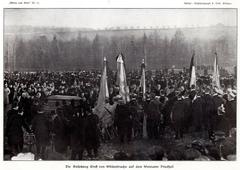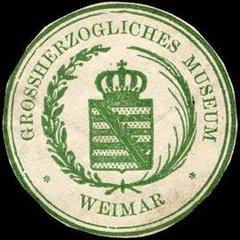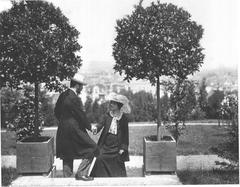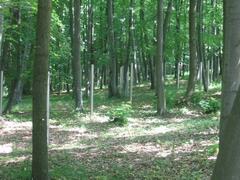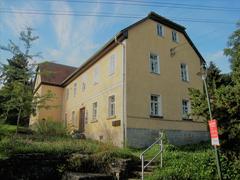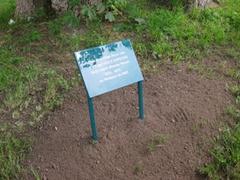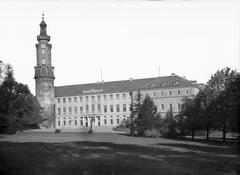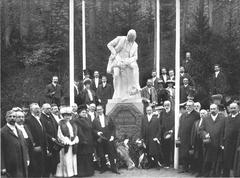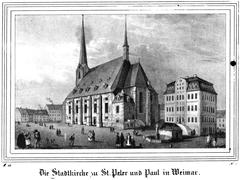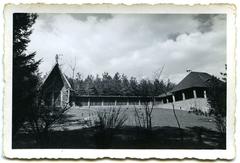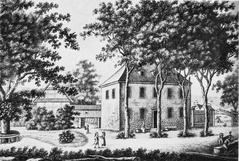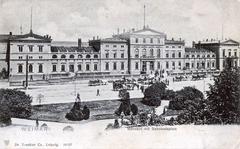Rittergasse 3, Weimar, Germany: Visiting Hours, Tickets, and Travel Guide
Date: 14/06/2025
Introduction
Rittergasse 3 is a distinguished address in the heart of Weimar’s Altstadt (Old Town), offering a unique glimpse into the city’s centuries-old architectural and cultural heritage. Although primarily a residential building not open for interior public visits, its preserved façade and setting within a UNESCO World Heritage ensemble make it a must-see for anyone interested in Weimar’s rich past. This comprehensive guide provides detailed information on the history, significance, practical visitor details, and travel tips for exploring Rittergasse 3 and its surroundings. Whether you are a history enthusiast or a casual traveler, Rittergasse 3 serves as an evocative window into the layered story of Weimar.
(Wikiwand – Rittergasse, Weimar.de, zeitsprung.animaux.de, Urban Meanderer)
Table of Contents
- Historical Development of Rittergasse
- Architectural and Cultural Significance
- Rittergasse 3: Monument Overview & Visitor Details
- Notable Residents and Historical Associations
- Urban Context and Preservation
- Rittergasse 3 in the Modern Visitor Experience
- Practical Visitor Information
- Cultural Heritage Status
- Frequently Asked Questions (FAQs)
- Expert Tips for a Memorable Visit
- Summary Table: Key Facts
- Internal Links for Further Exploration
- Call to Action
Historical Development of Rittergasse
Rittergasse is one of Weimar’s oldest streets, stretching from Herderplatz to the Zeughof and the former Franziskanerkloster on Geleitstraße. The street’s name references the Teutonic Knights (“Deutschritter”) who once resided here, and its history spans from the medieval period through the city’s classical era to modern times. During the Renaissance, Rittergasse featured many significant buildings, some of which were destroyed in World War II and subsequently reconstructed during the DDR (East German) era. Today, the street retains its charming cobblestone paving, historic façades, and blend of residential and cultural sites, reflecting Weimar’s ongoing urban evolution.
(Wikiwand – Rittergasse, Urban Meanderer)
Architectural and Cultural Significance
Rittergasse is celebrated for its architectural diversity, featuring Renaissance, Baroque, and Classical styles. Notable landmarks include the Donndorf-Brunnen, a fountain created in 1895 by sculptor Adolf von Donndorf, and the nearby Herderplatz and Stadtschloss. The street’s artistic heritage is underscored by the presence of historic facades, including that of Rittergasse 3, and its favored status among artists, intellectuals, and nobility throughout Weimar’s history.
Rittergasse 3: Monument Overview & Visitor Details
Historical Overview
Rittergasse 3 is officially listed as a cultural monument (Einzeldenkmal), representing classic Weimar urban residential architecture. The building’s origins can be traced to the classical period, with significant 19th-century renovations. Its elegant yet modest façade is typical of the city’s bourgeois dwellings and forms part of Weimar’s UNESCO World Heritage ensemble, reflecting the city’s role in European cultural history.
(Wikiwand – Rittergasse, Weimar.de)
Visiting Hours and Tickets
- Exterior Viewing: As Rittergasse 3 is a residential building, interior access is not available to the public. The exterior can be viewed at any time; the street is accessible 24/7.
- Guided Tours: Walking tours of the Altstadt often include Rittergasse 3. These typically start from Marktplatz and may require advance booking or tickets. For up-to-date schedules, consult the Weimar Tourist Information.
Notable Residents and Historical Associations
While Rittergasse 5 is the birthplace of sculptor Adolf von Donndorf and Rittergasse 19 housed writer Christoph Martin Wieland, Rittergasse 3’s designation as a cultural monument suggests its own significance within Weimar’s educated middle class. The street’s overall ambiance has long attracted artists, writers, and intellectuals, contributing to Weimar’s identity as a center of German Classicism and Enlightenment.
(Wikiwand – Rittergasse, Nevermore Poem – The Weimar Circle)
Urban Context and Preservation
Rittergasse’s narrow, winding layout and closely spaced buildings are typical of medieval German towns. Despite damage during WWII, postwar and DDR-era restoration efforts have preserved the historical character of the street, with reconstructed facades and original architectural details. This careful preservation maintains the authentic atmosphere of Weimar’s historic center.
Rittergasse 3 in the Modern Visitor Experience
Rittergasse 3 is a highlight on guided walking tours of Weimar’s Altstadt. Its central location ensures easy access by foot from the train station or city center. The area is well-served by cafes, shops, and restaurants, making it convenient for exploring Weimar’s cultural offerings. Visitors are encouraged to photograph the street’s historic facades and utilize digital resources, such as interactive maps or virtual tours, to enhance their experience.
(Urban Meanderer, Borders of Adventure)
Visuals and Media Recommendations
- Use descriptive alt tags for images, e.g., “Rittergasse 3 facade in Weimar historic district.”
- Explore official tourism websites for interactive maps and virtual tours.
Practical Visitor Information
- Location: Rittergasse 3, 99423 Weimar, Germany, near Geleitstraße and Herderplatz.
- Access: Pedestrian-friendly; best explored on foot.
- Tickets: None required for exterior viewing; guided tours may require tickets.
- Opening Hours: Street open 24/7; no interior access.
- Nearby Attractions: Donndorf-Brunnen, Herderplatz, Stadtschloss, Zeughof, Goethe National Museum.
- Tips: Early morning or late afternoon visits offer better light and fewer crowds; comfortable footwear recommended for cobblestones.
Cultural Heritage Status
Rittergasse 3 is a protected cultural monument under local and national heritage laws. Its preservation is part of the broader effort to maintain Weimar’s historic core, ensuring that any renovations adhere to strict guidelines and that the building’s historical integrity is maintained.
Frequently Asked Questions (FAQs)
Q: What are the visiting hours for Rittergasse 3?
A: Rittergasse 3 is a residential building; its exterior can be viewed any time, but there is no public interior access.
Q: Are tickets required?
A: No tickets are needed to view the exterior. Guided tours may require advance booking.
Q: Are guided tours available?
A: Yes, walking tours including Rittergasse 3 run daily from the tourist information center; check schedules in advance.
Q: Is the area accessible for visitors with disabilities?
A: Cobblestone paving may pose challenges; some nearby museums have improved accessibility.
Q: What are nearby attractions?
A: Donndorf-Brunnen, Herderplatz, Stadtschloss, and the Goethe National Museum are all within walking distance.
Expert Tips for a Memorable Visit
- Combine Rittergasse 3 with other Altstadt sites for a comprehensive experience.
- Early morning or late afternoon visits are ideal for photography.
- Check Weimar’s cultural calendar for festivals, concerts, and special events.
- Wear comfortable shoes for navigating cobblestone streets.
Summary Table: Key Facts
| Feature | Details |
|---|---|
| Address | Rittergasse 3, 99423 Weimar, Germany |
| Heritage Status | Listed cultural monument (Einzeldenkmal) |
| Architectural Style | Classical/19th-century urban residential |
| Notable Nearby Sites | Donndorf-Brunnen, Herderplatz, Stadtschloss, Zeughof |
| Accessibility | Exterior view only; street open 24/7 |
| Guided Tours | Available daily from Marktplatz tourist information |
| Cultural Significance | Part of Weimar’s UNESCO World Heritage ensemble |
| Restoration | Post-WWII and DDR-era faithful reconstruction |
| Best Time to Visit | Early morning or late afternoon for fewer crowds and better lighting |
Internal Links for Further Exploration
Call to Action
Plan your visit to Rittergasse 3 and immerse yourself in the vibrant history of Weimar’s Altstadt. For an enhanced experience, download the Audiala app for guided audio tours and insider tips, and follow us on social media for updates and travel inspiration.
Sources
- Rittergasse in Weimar: Visiting Hours, Tickets, Historical Significance, and Travel Tips for Exploring Weimar’s Historic Street, 2025, Urban Meanderer
- Rittergasse 3 Weimar: Visiting Hours, Tickets, and Historical Significance of Weimar’s Hidden Gem, 2025, zeitsprung.animaux.de
- Visiting Rittergasse 3 in Weimar: Hours, Tickets & Nearby Historical Sites, 2025, PlanetWare and Hayllar Music Tours, https://hayllarmusictours.com/2025-tours/in-the-footsteps-of-bach
- Exploring Rittergasse 3 and Weimar Historical Sites: Visiting Hours, Tickets, and Visitor Guide, 2025, Weimar.de and onlinestreet.de, https://de.wikipedia.org/wiki/Rittergasse_(Weimar)
- Wikiwand – Rittergasse, 2025
- Weimar.de Tourism Portal, 2025
- Klassik Stiftung Weimar, 2025
